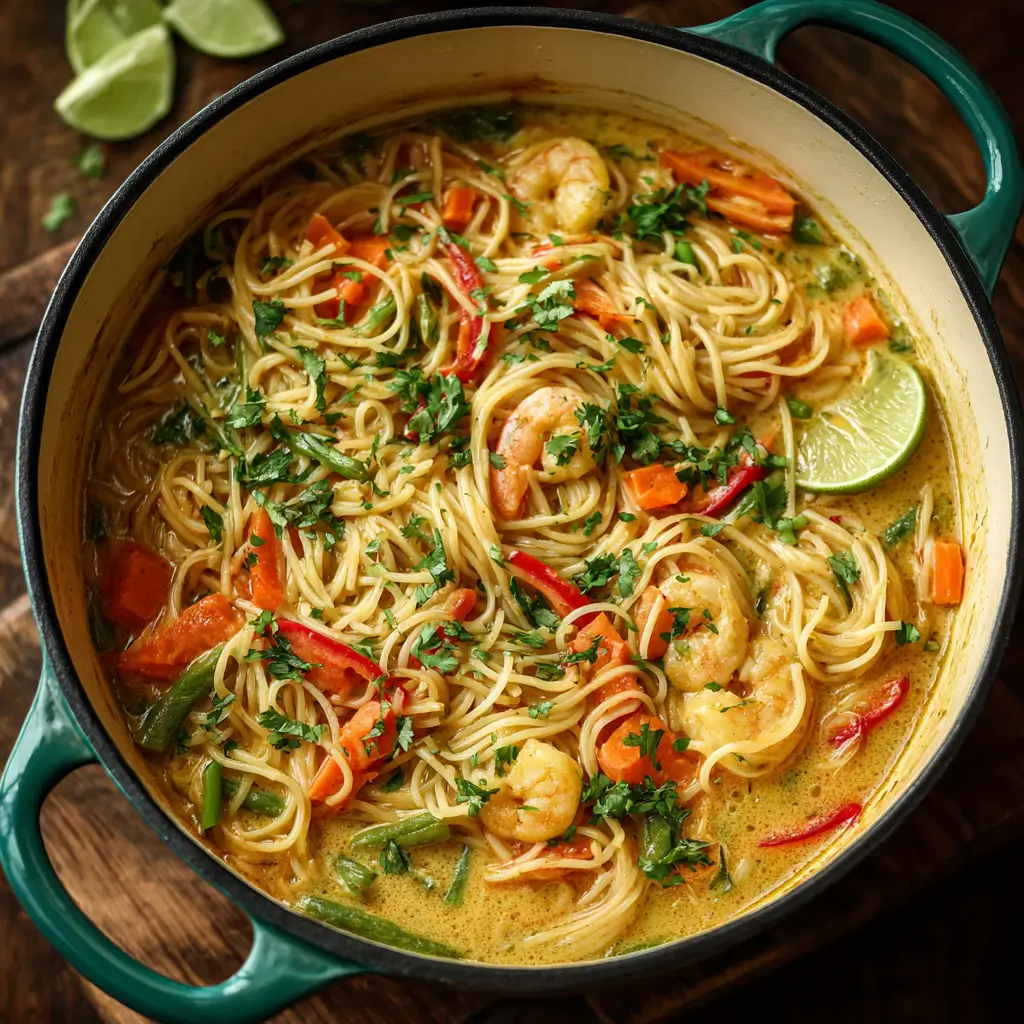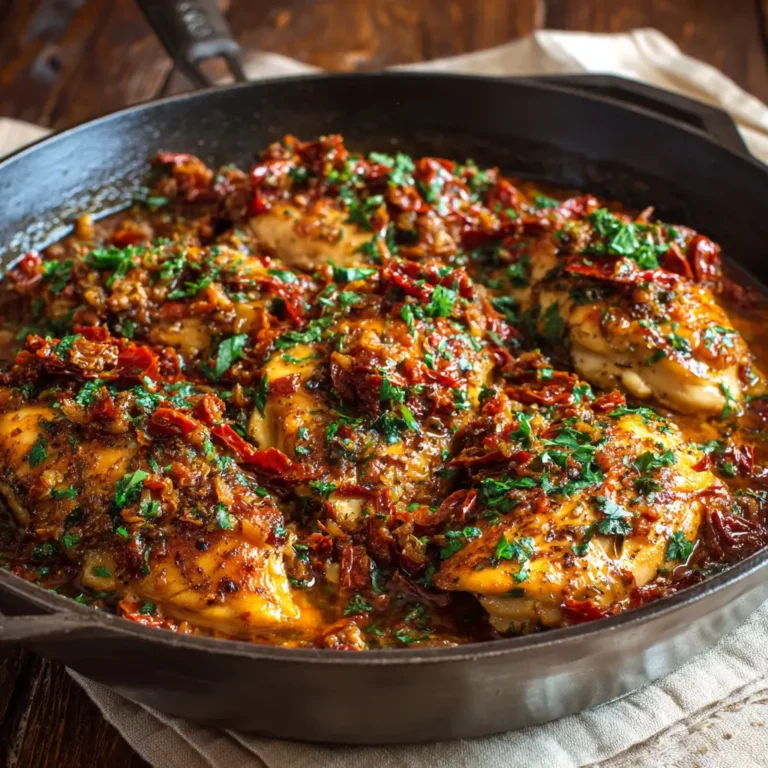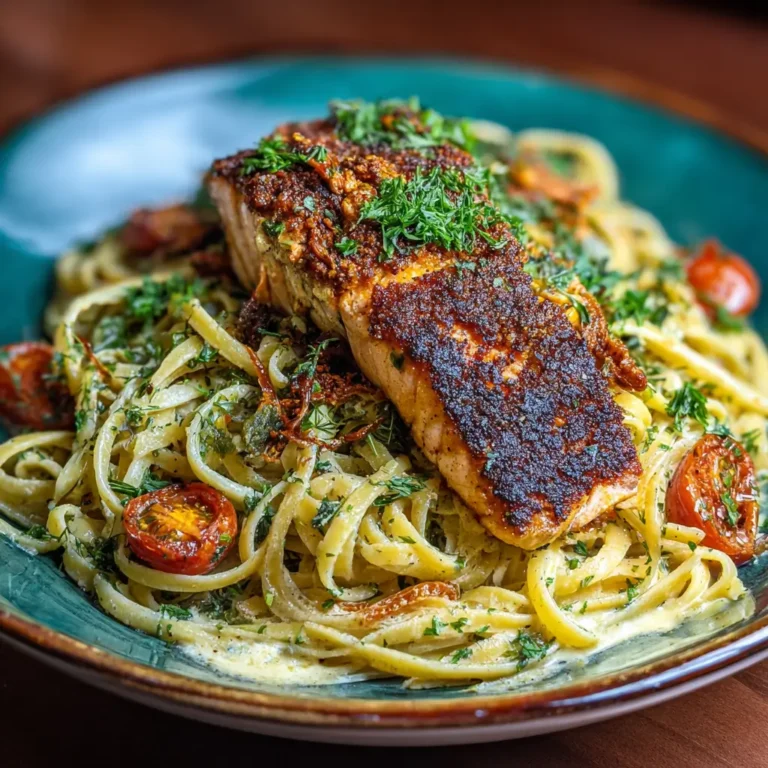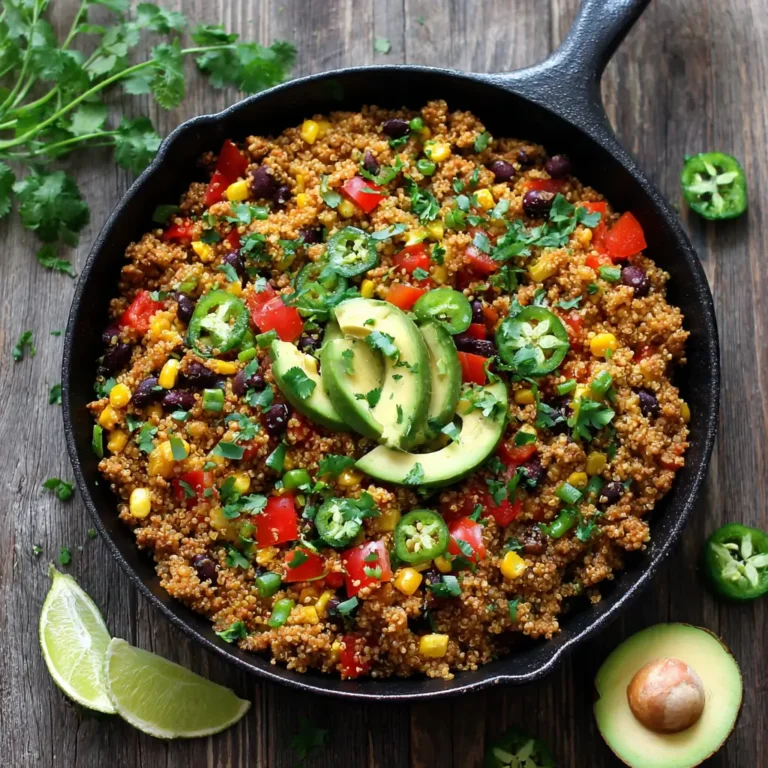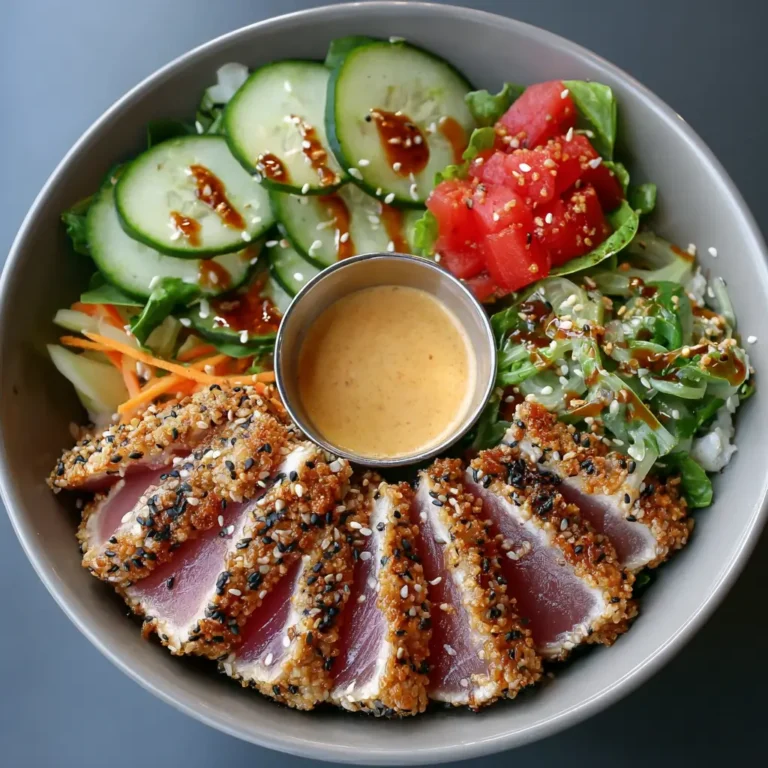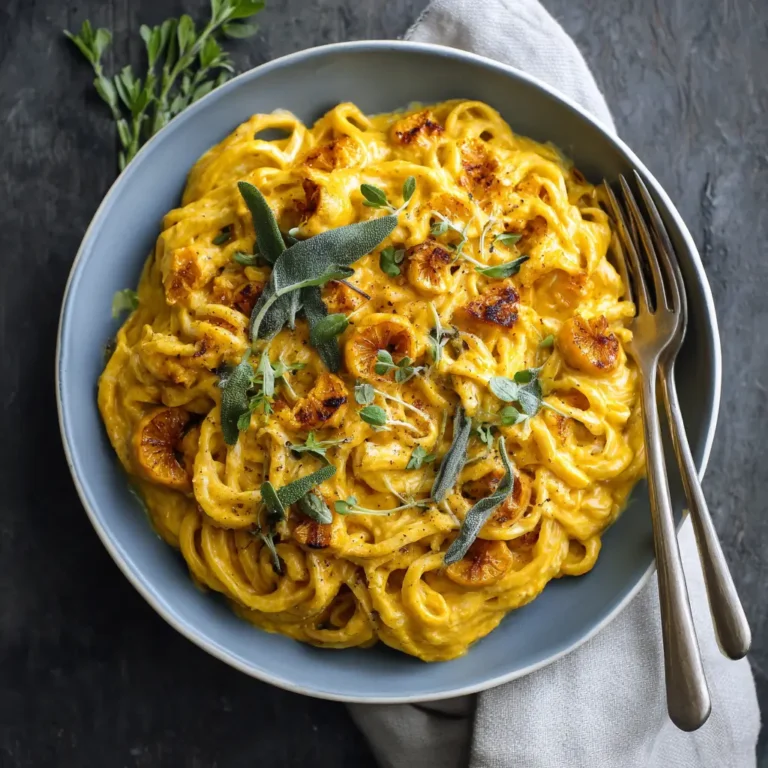One‑Pot Thai Coconut Curry Noodles
One-Pot Thai Coconut Curry Noodles: A Flavorful, Effortless Delight
If you’re craving bold, aromatic flavors without the hassle of multiple pots and pans, then One-Pot Thai Coconut Curry Noodles are your new go-to weeknight dinner. This rich, creamy, and deeply satisfying dish combines the vibrant essence of Thai cuisine—coconut milk, fragrant curry paste, fresh herbs, and tender noodles—all cooked in a single pot for maximum flavor and minimal cleanup. Whether you’re a seasoned cook or just starting out in the kitchen, this recipe is designed to be approachable, customizable, and utterly delicious.
The History Behind Thai Coconut Curry Noodles
Thai cuisine is renowned for its balance of sweet, sour, salty, bitter, and umami flavors. Curries, in particular, have been a staple in Thai households for centuries, with regional variations across Central, Northern, Eastern, and Southern Thailand. The use of coconut milk in curries dates back generations, especially in Southern Thailand where coconuts grow abundantly along the coastlines. Traditional Thai curries like kaeng som, kaeng phet (red curry), and kaeng kari (yellow curry) often feature coconut milk as a base to mellow the heat of chilies and enhance the richness of the dish.
Noodle-based versions of Thai curries evolved as urban food culture flourished, blending street food influences with home cooking. Dishes like Khao Soi from Chiang Mai showcase how coconut milk and curry spices can transform simple noodles into a luxurious meal. The modern “one-pot” adaptation of Thai coconut curry noodles reflects contemporary cooking trends—quick, efficient, and full of global flavors—while still honoring traditional ingredients and techniques. Today, this one-pot version has become a favorite among home cooks worldwide who want restaurant-quality Thai food in under 30 minutes.
Ingredients Breakdown: What Makes This Dish Shine
The magic of One-Pot Thai Coconut Curry Noodles lies in its carefully balanced ingredients that deliver depth, creaminess, heat, and freshness in every bite. Let’s take a closer look at each component:
- Coconut Milk: Full-fat coconut milk is essential for creating a luxuriously creamy texture and carrying the complex flavors of the curry. It also helps temper the spice from the curry paste.
- Thai Red or Green Curry Paste: Store-bought or homemade curry paste forms the soul of the dish. Red curry paste tends to be spicier and more robust, while green offers a fresher, herbal note. Look for brands with minimal additives or make your own using lemongrass, galangal, kaffir lime zest, chilies, garlic, and shrimp paste.
- Rice Noodles: Flat rice noodles (like pad Thai noodles or linguine-shaped) work best as they absorb the sauce beautifully without becoming mushy. Gluten-free and vegan-friendly, they complement the light yet hearty nature of the curry.
- Vegetables: Common additions include bell peppers, carrots, broccoli, mushrooms, spinach, and snap peas. These add color, nutrients, and textural contrast.
- Protein (Optional): Chicken, shrimp, tofu, or tempeh can be added for extra heartiness. Pre-cooked proteins integrate quickly, while raw proteins should be seared before adding liquids.
- Fish Sauce: A cornerstone of Thai flavor, fish sauce adds savory umami depth. For a vegetarian version, substitute with soy sauce or tamari.
- Lime Juice: Freshly squeezed lime juice brightens the entire dish, cutting through the richness of the coconut milk and balancing the sweetness and spice.
- Thai Basil & Cilantro: These aromatic herbs are not optional—they bring a citrusy, peppery freshness that defines authentic Thai taste.
- Sweetener: A touch of palm sugar, brown sugar, or honey rounds out the flavors and enhances the natural sweetness of the coconut milk.
- Garlic & Ginger: Minced garlic and grated ginger build the foundational aroma and warmth in the curry base.
- Vegetable Broth or Water: Used to adjust consistency and ensure the noodles cook evenly without drying out.
Step-by-Step Recipe: How to Make One-Pot Thai Coconut Curry Noodles
Follow these detailed steps to create a restaurant-worthy Thai coconut curry noodle dish right in your own kitchen—with only one pot!
- Gather and Prep Ingredients: Before you begin, chop all vegetables, measure out liquids, mince garlic, grate ginger, slice protein if using, and have your herbs ready. Mise en place ensures smooth cooking.
- Heat the Pot: Place a large, deep skillet or Dutch oven over medium heat. Add 1 tablespoon of neutral oil (such as avocado or coconut oil).
- Sauté Aromatics: Add 3 cloves of minced garlic and 1 tablespoon of freshly grated ginger. Sauté for about 30 seconds until fragrant but not browned.
- Bloom the Curry Paste: Stir in 3–4 tablespoons of Thai red or green curry paste. Cook for 1–2 minutes, stirring constantly, to release the essential oils and intensify the flavor.
- Add Coconut Milk: Pour in 1 can (13.5 oz) of full-fat coconut milk. Whisk well to combine with the curry paste, creating a smooth, fragrant sauce.
- Incorporate Broth and Seasonings: Add 1 cup of vegetable broth (or water), 2 tablespoons of fish sauce (or soy sauce), and 1 tablespoon of palm sugar (or brown sugar). Stir to blend.
- Add Vegetables: Toss in chopped vegetables such as 1 sliced bell pepper, 1 diced carrot, and 1 cup of broccoli florets. Simmer for 3–4 minutes until slightly softened.
- Add Protein (if using): If using raw chicken, shrimp, or tofu, add it now and simmer for 5–7 minutes until cooked through. For pre-cooked protein, add later.
- Add Noodles and Liquid: Break rice noodles to fit the pot and submerge them into the liquid. Add an additional ½ to 1 cup of broth or water as needed to cover the noodles completely.
- Cook Until Tender: Bring to a gentle simmer, then reduce heat to medium-low. Stir occasionally and cook for 8–10 minutes, or until noodles are al dente and have absorbed most of the liquid. Add more liquid if the mixture becomes too thick.
- Finish with Freshness: Remove from heat. Stir in juice of 1 lime, a handful of fresh Thai basil leaves, and chopped cilantro. Taste and adjust seasoning—add more fish sauce for saltiness, sugar for sweetness, or chili flakes for heat.
- Serve Immediately: Ladle into bowls and garnish with extra herbs, sliced red chili, crushed peanuts, or a wedge of lime on the side.
Tips for Perfect One-Pot Thai Coconut Curry Noodles
- Don’t Skip Blooming the Curry Paste: Cooking the curry paste in oil unlocks its full flavor potential and removes any raw edge.
- Use Full-Fat Coconut Milk: Light coconut milk will result in a watery, less flavorful curry. Shake the can well before opening, or stir thoroughly if using carton-packaged coconut milk.
- Adjust Spice Level: Start with 2 tablespoons of curry paste and add more gradually. You can always increase heat, but you can’t remove it.
- Avoid Overcooking Noodles: Rice noodles become gummy if overcooked. Check early and aim for al dente. They’ll continue to absorb sauce even after removal from heat.
- Stir Gently: Use a wooden spoon or silicone spatula to prevent breaking the noodles while ensuring even distribution of sauce.
- Balance the Flavors: Always finish with lime juice and a pinch of sugar to achieve the classic Thai harmony of sour, sweet, salty, and spicy.
- Keep Extra Liquid Handy: Have warm broth or water nearby to loosen the sauce if the pot gets too dry during cooking.
- Prep Ahead: Chop all ingredients in advance. This dish comes together quickly once you start cooking.
Variations and Customizations
The beauty of this recipe is its versatility. Here are some creative ways to customize your One-Pot Thai Coconut Curry Noodles:
- Curry Type: Swap red curry paste for green, yellow, Massaman, or Panang curry paste for different flavor profiles.
- Gluten-Free Version: Use tamari instead of soy sauce and confirm that your curry paste is gluten-free (some contain wheat).
- Vegan Option: Omit fish sauce or replace with vegan fish sauce or extra soy sauce. Use tofu or chickpeas as protein.
- Low-Carb/Keto Adaptation: Replace rice noodles with spiralized zucchini (zoodles) or shirataki noodles. Add more healthy fats like avocado or coconut oil.
- Extra Creamy Version: Stir in 1–2 tablespoons of peanut butter or almond butter for a richer, nuttier sauce reminiscent of satay.
- Seafood Lover’s Twist: Combine shrimp, scallops, and mussels for a Thai-inspired seafood curry noodle bowl.
- Spicy Kick: Add sliced bird’s eye chilies, chili oil, or sriracha for extra heat.
- Noodle Swap: Try glass noodles (cellophane noodles), udon, or soba for different textures (adjust cooking times accordingly).
- Roasted Vegetable Upgrade: Roast your vegetables beforehand for deeper caramelized flavor before adding them to the pot.
- Herb Variations: Mint, lemon balm, or regular basil can be used if Thai basil isn’t available.
Health Considerations and Nutritional Value
One-Pot Thai Coconut Curry Noodles can be both indulgent and nutritious, depending on ingredient choices and portion size. Here’s a breakdown of key nutritional aspects:
- Coconut Milk: High in saturated fat, but primarily medium-chain triglycerides (MCTs), which are metabolized differently than long-chain fats and may support energy and metabolism. Moderation is key, especially for those monitoring cholesterol.
- Vegetables: Packed with fiber, vitamins (A, C, K), antioxidants, and phytonutrients. The more colorful the veggies, the broader the nutrient spectrum.
- Protein Options: Tofu and legumes provide plant-based protein and fiber. Shrimp and chicken offer lean animal protein with essential amino acids.
- Low Sodium Option: Use low-sodium soy sauce or tamari and limit added salt. Rely on herbs, lime, and spices for flavor instead.
- Gluten-Free Friendly: Naturally gluten-free when using rice noodles and certified gluten-free sauces.
- Calorie Control: A typical serving ranges from 400–600 calories, depending on ingredients. Reduce coconut milk slightly and boost veggies to lower calories.
- Digestive Benefits: Ginger and garlic aid digestion and have anti-inflammatory properties. Lemongrass (in curry paste) may also support gut health.
- Omega-3s (with Fish): Adding salmon or shrimp introduces heart-healthy omega-3 fatty acids.
Overall, this dish offers a balanced profile when made with whole ingredients and mindful portions. It supports immune function, energy levels, and gut health while delivering a satisfying, flavorful experience.
Ingredients
- 1 tbsp coconut or avocado oil
- 3 cloves garlic, minced
- 1 tbsp fresh ginger, grated
- 3–4 tbsp Thai red or green curry paste (adjust to taste)
- 1 (13.5 oz) can full-fat coconut milk
- 1 cup vegetable broth (or water)
- 2 tbsp fish sauce (or soy sauce/tamari for vegetarian)
- 1 tbsp palm sugar, brown sugar, or honey
- 1 medium bell pepper, thinly sliced
- 1 carrot, julienned or thinly sliced
- 1 cup broccoli florets
- 4 oz rice noodles (flat or round, about 1/2 inch wide)
- Optional protein: 8 oz cooked chicken, shrimp, tofu, or tempeh
- Juice of 1 lime
- 1/2 cup fresh Thai basil leaves, plus more for garnish
- 1/4 cup fresh cilantro, chopped
- Optional toppings: crushed peanuts, sliced red chili, lime wedges, scallions
Directions
- Heat oil in a large pot or deep skillet over medium heat. Add garlic and ginger; sauté for 30 seconds until fragrant.
- Stir in curry paste and cook for 1–2 minutes, stirring constantly to bloom the spices.
- Pour in coconut milk, broth, fish sauce, and sugar. Whisk to combine and bring to a gentle simmer.
- Add bell pepper, carrot, and broccoli. Simmer for 4 minutes until vegetables begin to soften.
- If using raw protein (chicken, shrimp, tofu), add now and cook for 5–7 minutes until done.
- Break rice noodles to fit the pot and add them to the mixture. Pour in additional broth or water as needed to submerge the noodles.
- Simmer gently for 8–10 minutes, stirring occasionally, until noodles are tender and most of the liquid is absorbed.
- Remove from heat. Stir in lime juice, Thai basil, and cilantro. Taste and adjust seasoning—add more fish sauce for salt, sugar for sweetness, or chili for heat.
- Serve immediately in bowls, garnished with extra herbs, crushed peanuts, sliced chili, and lime wedges on the side.
FAQ
Can I make this ahead of time?
Yes, though best served fresh. Reheat gently with a splash of water or broth to loosen the sauce, as rice noodles absorb liquid when chilled.
Can I freeze leftovers?
Freezing is not recommended due to the coconut milk separating and noodles becoming mushy upon thawing. Enjoy within 3 days refrigerated.
What if my curry is too spicy?
Add more coconut milk, a dollop of plain yogurt (if not vegan), or a bit more sugar to balance the heat.
Can I use canned coconut milk from a carton?
Only if labeled “cooking coconut milk” or “full-fat.” Regular beverage-style coconut milk is too thin and lacks richness.
Are rice noodles gluten-free?
Yes, traditionally made from rice flour and water. Always check packaging for cross-contamination if sensitive.
Can I use frozen vegetables?
Yes, but add them later in the process to avoid excess water. Thaw and drain first for better texture.
How do I prevent the bottom from burning?
Use medium-low heat after initial sautéing, stir frequently, and maintain enough liquid in the pot at all times.
Can I make it spicier?
Absolutely! Add fresh chilies, chili garlic sauce, or a pinch of cayenne when blooming the curry paste.
Summary
One-Pot Thai Coconut Curry Noodles deliver bold, aromatic flavors with minimal effort—perfect for busy nights when you want something fast, delicious, and satisfying. Packed with vibrant vegetables, creamy coconut milk, and fragrant spices, this dish brings the taste of Thailand straight to your table.
